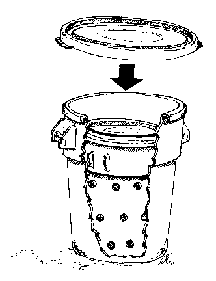
Building a Two-Can Bioreactor

Purpose
Two-can bioreactors are designed to be used as small-scall indoor composting units for families,
and for composting as an educational tool in the classroom.
Materials
- 32-gallon plastic garbage can
- 20-gallon plastic garbage can
- drill
- brick
- spigot (optional)
- duct tape (optional)
- insulation (optional)
 Construction
Construction
- Using a drill, make 15 to 20 holes (0.5" to 1" diameter) through the bottom of the 20-gallon can. Next drill three rows of holes through the sides of this can, six to eight inches apart with four to five inches between rows, ending about two inches below where the can expands at the top.

- Place a brick or some other object in the bottom of the 32-gallon can. This is to separate the leachate from the compost and allow for its measurement and addition back into the compost pile. The leachate, often referred to as "compost tea," is rich in nutrients which may be in a form readily usable by plants. If not used right away on growing plants, pour the leachate back into the compost. Excessive leachate can be responsible for foul smells. If your sytem produces enough leachage to cause odor problems, your initialscompost mixture was probably too wet.
- Variations on the design:
- Add insulation to the barrels (inner and outer) with duct tape.
- Include a spigot to draw off the leachate.
- Add a layer of old compost, wood chips, or soil inside the outer barrel. This will allow the leachate to be absorbed and may cause fewer leachate/odor issues.
Note: A system of 10-gallon plastic garbage cans that can fit inside 20-gallon cans can be substituted if space is a problem. The smaller system may operate at lower temperatures. This should not affect the final product; it will just take longer before the product can be used.
The composting process in the cans will take from three to five weeks. After this period, you can transfer the compost to other containers or an outdoor pile for several weeks of curing while starting up a new batch of compost in the 2-can system.
Credits

